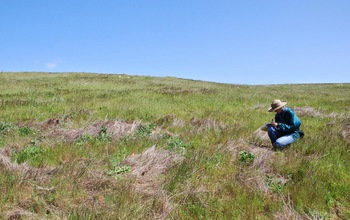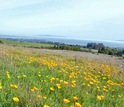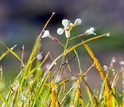Hola amigos: A VUELO DE UN QUINDE EL BLOG., hemos recibido información de la Fundación Nacional de Ciencias de Los Estados unidos, con ocasión sobre la celebración del Día de la Tierra, que nos aseguran que la propagación de enfermedades entre las especies ahora es predecible.
NSF, nos dice : "En el Día de la Tierra, un estudio de la dinámica de la enfermedad en un prado de California ha revelado los principios fundamentales que subyacen a la propagación de agentes patógenos o microbios causantes de enfermedades, entre las especies.
Los resultados, anunciados hoy en la revista Nature, tienen implicaciones para el mantenimiento de la biodiversidad y para hacer frente a los problemas prácticos relacionados con enfermedades de las plantas....."
Los resultados, anunciados hoy en la revista Nature, tienen implicaciones para el mantenimiento de la biodiversidad y para hacer frente a los problemas prácticos relacionados con enfermedades de las plantas....."
NSF, agrega: " Investigadores de la Universidad de California, en Santa Cruz, estudiaron el fenómeno de "spillover patógeno" en especies de pastizales en el campus de la Universidad de California en Santa Cruz......
Ellos encontraron que la cantidad de enfermedades presentes en cada especie podía predecirse por la abundancia de sus parientes cercanos en el pastizal. Cuando había muchos individuos de la misma o similar especies que viven cerca juntos, los patógenos se propagan más rápidamente.
Aunque parezca increíble, que a su vez promueve la biodiversidad mediante la creación de aberturas para las especies menos comunes que no son atacadas por estos mismos agentes patógenos...."
Aunque parezca increíble, que a su vez promueve la biodiversidad mediante la creación de aberturas para las especies menos comunes que no son atacadas por estos mismos agentes patógenos...."
Study in California grassland expands understanding of biodiversity and management of emerging diseases
 Credit and Larger Version |
On Earth Day, a study of disease dynamics in a California grassland has revealed fundamental principles underlying the spread of pathogens, or disease-causing microbes, among species.
The results, announced today in the journal Nature, have implications for the maintenance of biodiversity and for addressing practical problems related to plant disease.
Researchers at the University of California, Santa Cruz, studied the phenomenon of "pathogen spillover" in grassland species on the UC Santa Cruz campus.
They found that the amount of disease present on each species could be predicted by the abundance of its close relatives in the grassland. When there were many individuals of the same or similar species living close together, pathogens spread more quickly.
Perhaps unexpectedly, that in turn promotes biodiversity by creating openings for less common species that are not attacked by these same pathogens.
Link between community structure and individual disease vulnerability
The findings reveal a tight link between the structure of a plant community and the vulnerability of individual species to disease.
"These scientists demonstrate that the relatedness of species in communities is an important predictor of disease prevalence," said Alan Tessier, acting director of the National Science Foundation's (NSF) Division of Environmental Biology, which funded the research.
The researchers were able to predict which plant species introduced into the grassland would be most strongly affected by naturally-occurring diseases.
Ingrid Parker, an ecologist and evolutionary biologist at UC Santa Cruz and first author of the paper, said the study adds an important new dimension to a longstanding concept in ecology known as the "rare species advantage."
Diseases take greater toll on common species
"The rare species advantage is thought to be a major driver of biodiversity in natural ecosystems," Parker said. "Most pathogens are not host specialists--they can easily move from one species to another. Whether pathogens 'spill over' depends on how closely related other species nearby are.
"Our study shows that it's the structure of the whole community around a species that affects its vulnerability to disease."
Large-scale experiment with 44 plant species
In a large-scale experiment, the researchers introduced 44 plant species from outside California. (The plants were removed before they reproduced.)
The biologists found that species with few close relatives in the grassland escaped disease, while those closely related to many resident species always showed high levels of disease.
The researchers were able to make surprisingly accurate predictions of disease in introduced species based on their phylogenetic, or evolutionary, distance from local species.
"It was kind of shocking how well we were able to predict disease at a local scale," Parker said.
Modeling "PhyloSusceptibility"
To incorporate the phylogenetic distance between species into their predictions of disease dynamics, the researchers used a "PhyloSusceptibility model" developed by scientist Gregory Gilbert at UC Santa Cruz and two other paper co-authors, Roger Magarey and Karl Suiter of North Carolina State University, who work with the U.S. Department of Agriculture's (USDA) Animal and Plant Health Inspection Service.
The model is based on USDA's global database of fungal pathogens and host plants, and can be used to predict the probability of two species sharing a pathogen.
"If a plant pathogen from Brazil suddenly shows up in southern California, you want to know what plants in California are most likely to be attacked," Gilbert said.
By showing that the PhyloSusceptibility model makes accurate predictions, the results suggest a range of potential applications.
The PhyloSusceptibility model could help avoid disease problems affecting proposed horticultural imports or reforestation projects.
It could also be used in agriculture to design intercropping or rotation systems to decrease crop disease.
Vulnerability of local species to "pathogen spillover"
Imported plants can bring new pathogens and pests into an area. The PhyloSusceptibility model could be used to assess the vulnerability of local species to pathogen spillover from such plant introductions, the scientists say.
While the PhyloSusceptibility model used in this study was based on data for fungal pathogens, Gilbert said the team has also created versions based on data for eight other groups of pests and pathogens, including insects, nematodes, bacteria and viruses.
In addition to Parker, Gilbert, Magarey and Suiter, the co-authors of the study include UC Santa Cruz researchers Megan Saunders, Megan Bontrager, Andrew Weitz and Rebecca Hendricks.
USDA also funded the work.
-NSF-
Media Contacts Cheryl Dybas, NSF, (703) 292-7734, cdybas@nsf.gov
Tim Stephens, UCSC, (831) 459-4352, stephens@ucsc.edu
Tim Stephens, UCSC, (831) 459-4352, stephens@ucsc.edu
Related WebsitesNSF Grant: Rare-species advantage: consequences of phylogenetic and numerical rarity of hosts for disease pressure and pathogen communities:
http://www.nsf.gov/awardsearch/showAward?AWD_ID=0842059&HistoricalAwards=false
The National Science Foundation (NSF) is an independent federal agency that supports fundamental research and education across all fields of science and engineering. In fiscal year (FY) 2015, its budget is $7.3 billion. NSF funds reach all 50 states through grants to nearly 2,000 colleges, universities and other institutions. Each year, NSF receives about 48,000 competitive proposals for funding, and makes about 11,000 new funding awards. NSF also awards about $626 million in professional and service contracts yearly.
Useful NSF Web Sites:
NSF Home Page:
http://www.nsf.gov
NSF News:
http://www.nsf.gov/news/
For the News Media:
http://www.nsf.gov/news/newsroom.jsp
Science and Engineering Statistics:
http://www.nsf.gov/statistics/
Awards Searches:
http://www.nsf.gov/awardsearch/

An explosion of rare California poppies in the Great Meadow on the UCSC campus.
Credit and Larger Version

Wild radishes are surrounded by abundant diseased grasses.
Credit and Larger Version

Non-resident experimental plants are placed in a meadow to test for disease susceptibility.
Credit and Larger Version

Disease symptoms on common grass in the UCSC Great Meadow.
Credit and Larger Version

Researchers glue leaves of wild plants to blue paper for disease symptom assessment.
Credit and Larger Version
The National Science Foundation (NSF)
Guillermo Gonzalo Sánchez Achutegui
ayabaca@gmail.com
ayabaca@hotmail.com
ayabaca@yahoo.com
Inscríbete en el Foro del blog y participa : A Vuelo De Un Quinde - El Foro!

No hay comentarios:
Publicar un comentario